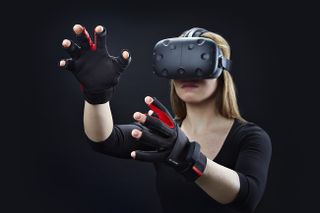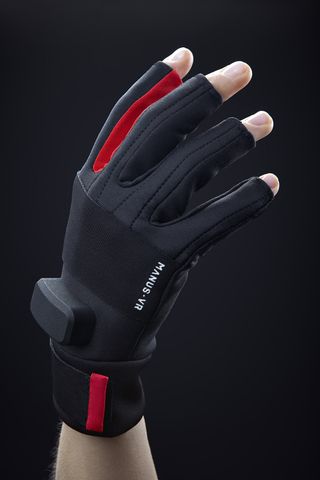Manus VR Glove Peripheral Dev Kits Cost $250, Available Q2

Manus VR is a Dutch startup, founded in 2014. The company has been designing a glove peripheral for virtual reality and has now revealed the design of its first developer kit, as well as when it will be available.
The Manus VR peripheral is a pair of gloves that features integrated circuitry designed to allow a number of different inputs. Each glove includes a nine degree of freedom (9DOF) IMU, and each finger has two bending sensors. The Manus VR gloves also offer haptic feedback provided by a fully programmable vibration motor. The company said the gloves are powered by rechargeable batteries that last up to eight hours.
Manus VR revealed that the gloves have two methods of communication: They can be connected with a USB dongle to offer latency lower than 5ms, or there is also a Bluetooth option that requires 12ms for communication. The company also noted that the gloves include wrist-mounted holders for the HTC Vive wand controllers, so the gloves can take advantage of Lighthouse tracking.
"The combination of the Manus glove, with Lighthouse positional tracking, promises an extremely immersive virtual reality experience, in which the player can interact with the virtual world around them in the same way they would interact with the real world. They have the potential to lift VR to a new level of immersion, promising to unleash the potential of a user’s hands into the virtual world," read the press release in part.
Manus VR said the gloves are made of “high tech textiles,” and the electronics inside are washable, so you can easily keep them clean.

Manus VR will be showing off its VR glove peripheral at GDC next week. The company partnered with Pillow’s Willow VR Studios, and the pair will be showcasing Pillow’s Willow, a puzzle game that Manus VR said requires hand interactions to solve. The company said this demo will demonstrate the Manus VR glove’s compatibility with the HTC Vive VR system.
Manus VR said that the SDK will be free and open source, and it has plug-ins for Unity, Unreal, Android, C#, 3DsMax and Maya "with other engines and development tools on the way." The Manus VR hardware developer kits will be available to pre-order in Q2 of this year for $250. The company expects to ship the dev kits in Q3.
Stay on the Cutting Edge
Join the experts who read Tom's Hardware for the inside track on enthusiast PC tech news — and have for over 25 years. We'll send breaking news and in-depth reviews of CPUs, GPUs, AI, maker hardware and more straight to your inbox.
Follow Kevin Carbotte @pumcypuhoy. Follow us on Facebook, Google+, RSS, Twitter and YouTube.
Kevin Carbotte is a contributing writer for Tom's Hardware who primarily covers VR and AR hardware. He has been writing for us for more than four years.
-
Warsaw This is exciting, I was waiting for a good glove to come out on VR. Looks promising, I'm hoping they have good execution with it.Reply -
outlw6669 9 Degrees of Freedom, how is that supposed to work?Reply
6 DoF are all you have in a 3D space.
Translation along X, Y and Z; Rotation around u, v and w... -
Pedasc Reply9 Degrees of Freedom, how is that supposed to work?
6 DoF are all you have in a 3D space.
Translation along X, Y and Z; Rotation around u, v and w...
In this case and in robotics it is a measure of capability. It defines the number and function of the sensors/actuators. I deal more with robotics and the DoF is basically the number of single axis joints it has (it can get more complicated). The higher number the more flexibility you have. Having a 9 DoF robot isn't uncommon or even that extreme. Of course in that case you introduce more error the more complexity you have.
I would say in this case it defines the number and function of sensors. It would be more accurate than a lower DoF system of similar resolution but would increase bandwidth needed of course. -
8R_Scotch ReplyI can just imagine the impact this will have on adult content.
I doubt you'd want such a thick/heavy glove on for adult content... washable or not.
This is interesting for more mainstream uses, but the problem with all these is developer/headset ecosystem support. Let's face it, VR is still in it's infancy (pre-birth, actually) and developers are taking risks as it is on it. Attractive input options are going to be Oculus Touch and the Vive's controllers (aside from the included x-box controller that most people who use controllers already use and regular joystics/wheels for specific content that's both simple and best for task).
These gadgets are all interesting, but at best they're technology is going to be incorporated into future options from the big VR players who will dictate the standard.
Hand gesture/motion tracking is the only thing that has a shot in my opinion as it's so natural and full of potential. But the tech is not there just yet.
Most Popular





